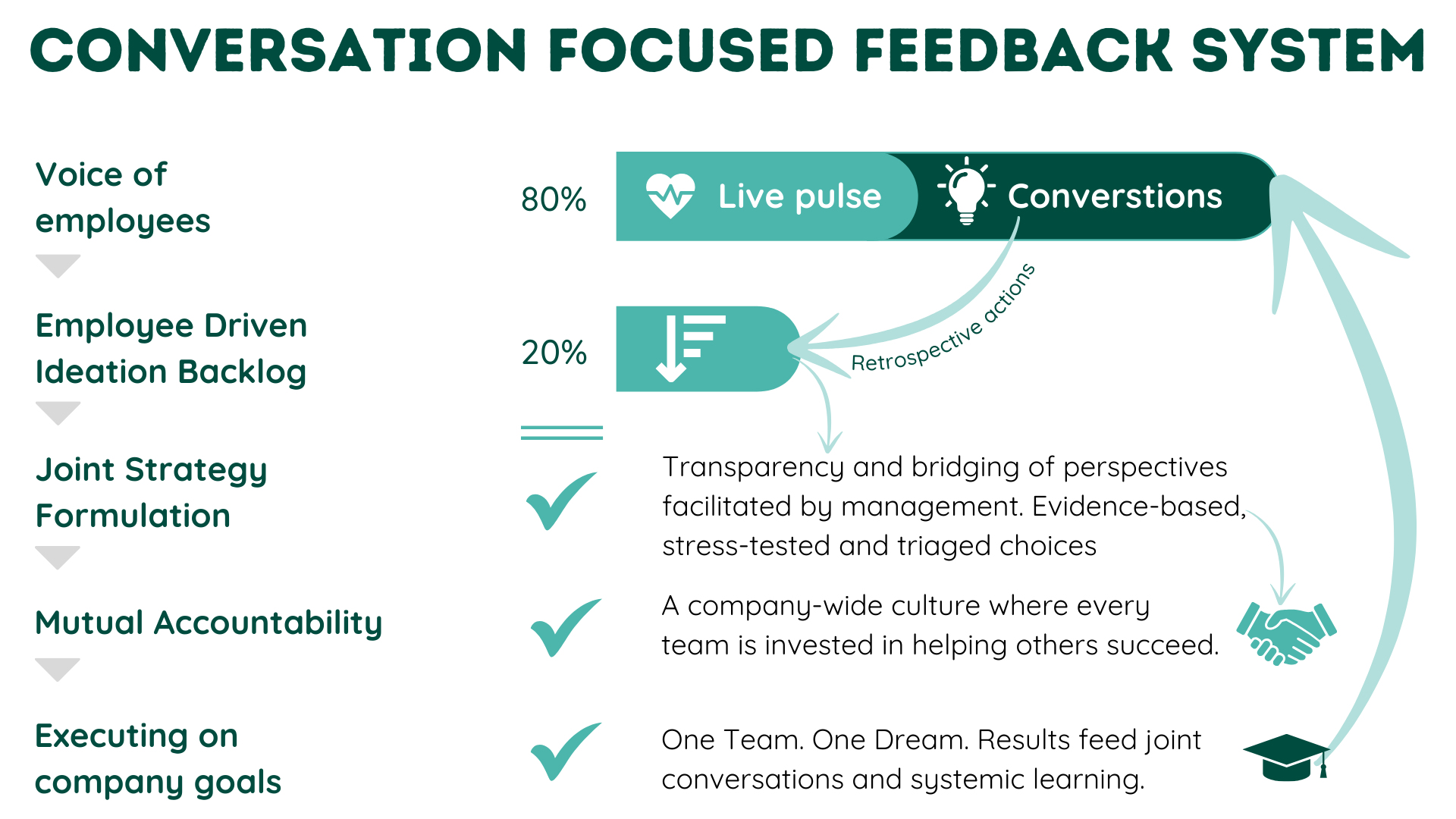Hearing The Voice of The Employees
Introduction
The journey of achieving and maintaining a vibrant employee engagement is dominated by a challenge of marrying feedback with action.
Companies invest efforts into periodic employee surveys in attempts to measure the level of psychological investment in the organization - this investment is often referred to as employee engagement. There are varying statistics (for instance
Gallup surveys) on the industry wide results. The status quo is that it is hard to achieve a level of engagement of above 70%. In this article we would like to challenge this status quo and suggest an approach that would allow any firm to achieve engagement levels closer to 100%.
Let's take a critical look at how the voice of employees is heard, interpreted and how it is used. This article proposes an approach to redefining the voice of employees and provides suggestions to recalibrate the approach to engaging the collective intellect of employees.
Introspection on employee engagement surveys
A straightforward definition of the voice of employees states - “it is a systematic process designed to uncover and assess employee concerns or problems that impact the total employer-employee relationship … so that the company can then act on the (employee) feedback, creating a better workplace for their employees with business goals in mind” - Gem Siocon, AHRI.
There are three key challenges with the voice of employees:
- The process is pre-conditioned to look at higher level themes only; This is because “the total relationship” is the originating concern - the scope is too big to unpack in a periodic survey;
- Discrete surveys always lag and are architected around pre-conditioned questions; It is hard for employees to feel that they are heard in their own words even if there is a box for freeform commentary;
- It is common for employees to under-report challenges that affect their everyday lives;
Let’s face it - it is not natural for a significant proportion of people to be transparent. There are three persona groups in each organization:
- “Quiet majority” remains quiet because surveys do not provide a way around psychological safety issues; Similarly, feedback is often constrained as a result of toxic positivity behaviors of managers;
- “Quiet high performers” feel that their systems thinking perspectives will not matter in the crowded pool of “complaints” or “kudos”;
- “Voiceful average performers” skew the voice of employees
In addition, some organizations have a fourth minority group - “Influential unicorns”. This group of people can cause the firm to deviate from the right course (in hindsight) by a few degrees, which can lead to the company missing the target by miles (akin to an aviation concept called the
1-in-60 Rule). The value of surveys where these people are in unchecked power is negligible.
Doubling down on management communications, surveys or even Ai tools, will not improve matters in a meaningful way. There are two fundamental reasons for this:
- Firstly, authentic leaders already know broad themes and sufficient details of what is bothering employees; If data points are not flowing through to management conversations, it is not for the lack of surveys but due to politics;
- Secondly, formulation of actions to address feedback is typically a separate stage in which employees are relatively powerless subjects; To make matters worse, strategy setting is a separate process altogether; Only a few bits of employee sentiment filter through to strategy;
Employee engagement that is over-reliant on annual or quarterly surveys does not make enough of a difference:
- In organizations with low trust and immature transparency, why would surveys change that status quo? Surveys that do not lead to a fundamental change devalue their usefulness because employees' collective brain “uses experience to determine if It's worth it … after you do something, you learn if it has value” - E. Paul Zehr Ph.D., Psychology Today.
- In organizations with healthy transparency and continuous improvement practices, surveys’ value is limited to being a checkpoint; Winning organizations pivot away from annual or quarterly surveys towards a live pulse system complimented with brainstorming sessions.
This statement may seem paradoxical from the perspective of a survey reliant approach - if you don't have to do many employee surveys, it means employees are likely having better experience. However, “research shows that people who report having a positive employee experience have 16 times the engagement level of employees with a negative experience, and that they are eight times more likely to want to stay at a company” -
McKinsey, 2021.
Are surveys useless?
The world around us is complex because products, services and interactions between partners are increasingly based on continuous and incremental changes. The approach to hearing employees should reflect this evolution. Organizations that choose to stick with legacy feedback systems will fall behind due to the effects of Conway's law.
Does this mean that organizations should move away from surveys? A generalist HR professional would have two core concerns:
- How would an organization benchmark itself against peers and competitors?
- If it is not surveys, what tools and guidelines would be provided to management?
Each of HR concerns can be responded as follows:
- The only reliable measures of employee engagement are the attrition rate and what people say about the company once they left;
- The need to measure employee sentiment does not go away; However, the approach to building actionable and evidence-based feedback flow needs principles and methods that match the complexity of the outside world;
What is the voice of employees?
Traditional HR approach dictates a waterfall set of activities : “gather feedback > process and examine feedback > represent feedback in management meetings > determine actions > planning of action > communication to employees > implementation > measure the impact of action”. In this system, “the why” is determined by a well-intended desire to identify actions that would improve the total employer-employee relationship.
Feedback systems that are over-reliant on traditional surveys have a fundamental data reliability challenge. Answers to questions might uncover perspective A and B, but true reality might be represented by perspective C that is born only through bridging perspectives and a joint brainstorming. Imagine this scenario:
- Group A of employees communicates feedback that we need more of X
- Group B or employees communicates feedback that we need more of Y
- If management were to triage employee feedback at their offsite and take feedback at face value, they it would try to spread what budgets allow between X and Y
- However, a well facilitated brainstorming session might reveal that employees would recommend merging groups A and B in order to do less of both X and Y, and instead invest more into Z
Surveys can relay the heartbeat but not the voice of employees.
We can re-imagine the voice of employees as a continuously maintained backlog of reconciled and ready-to-execute actions that are linked to business goals. It is important to note that managers are an integral part of the brainstorming process - they are employees like everyone else.
By listening to employee feedback via incubated backlog of actions (as opposed to discrete survey answers), organizations can achieve following:
- Reduce costs, because there is no need to over-invest into surveys
- Reduce effort of management communications, because this conversation path is embedded within the ideation and brainstorming process
- Boost capability of management to win hearts and minds of employees as a result of shoulder-to-shoulder participation in incubating ideas
- Unlocks opinions of the quiet majority, because thoughtfulness of the brainstorming process is better
- Unlock enthusiasm of high performers because the route to action is much more direct
Conclusion - recalibrating your approach to the voice of employees
The answer to why organizations need the voice of employees can be answered as follows:
- It is not for the purpose of enabling management to think up actions on the back of discrete data points
- Instead, it is for the purpose of having readily-executable backlog actions that promote company goals
Because the mission is to maximize the “total employer-employee relationship” and “psychological investment”, it is necessary to look at the voice of employees as a total package of communications, action and the response back to action.
Three simple steps are needed to upgrade a survey based approach to a conversation focused feedback-and-action system :
- Swap out surveys with a Live Pulse system that can channel feedback in real-time in a measurable and contextual form, at scale and at a team and organization-wide level (check out Neelix.IO Voice of Employees features)
- Extend existing team conversation pattern (typically retrospectives) with asynchronous ideation and brainstorming capabilities - these would host the backlog of incubated actions that speak what employee truly wish to happen
- Ensure a presence of employee activist during management meeting and strategic planning events
It is already the case with the traditional survey based process - that the hardest part is the action. A conversation focused feedback system is going to be subject to the same Pareto principle. The difference, however, is that by pivoting towards a system of conversations it is actually possible to achieve close to 100% of employee engagement. Traditional surveys based approaches can never achieve that.

The voice of employees is synonymous with transparency.
Transparency is significantly less about the “availability of information”. It is much more about the ability to have conversations that can challenge the status quo.
A tongue in cheek question - what does the voice of employees sound like in your company? Is it whispers, echoey sighs, church choir, or perhaps some rock band?



